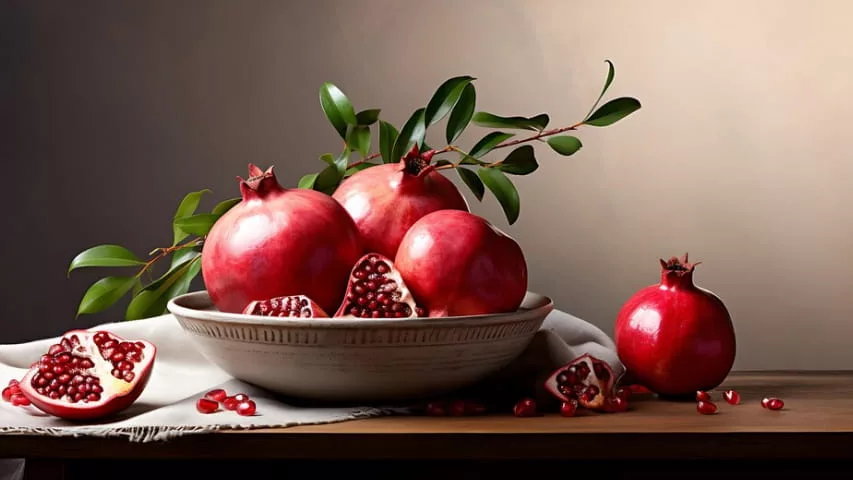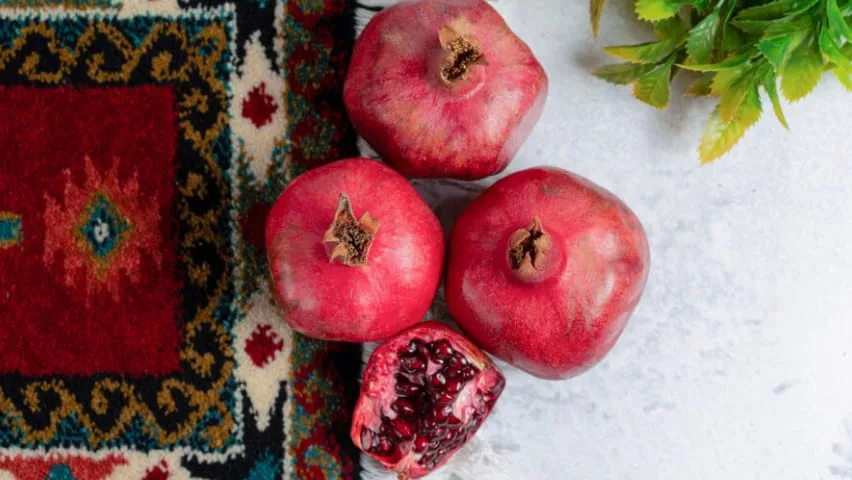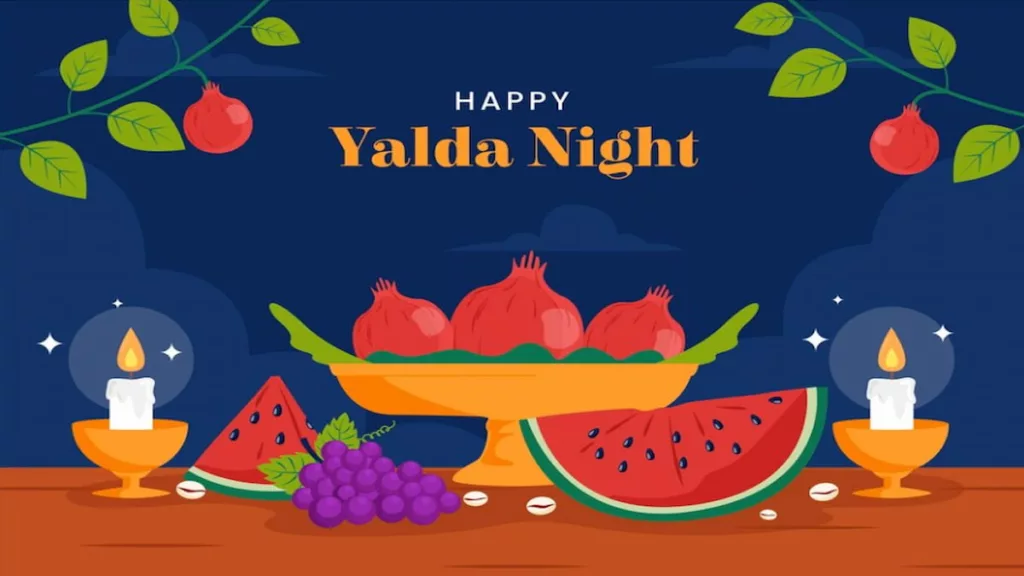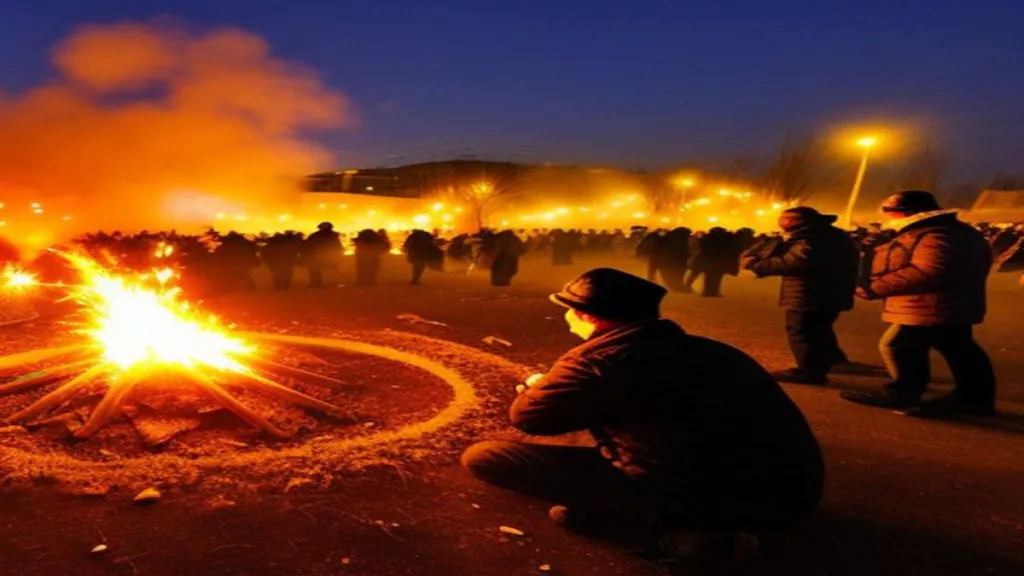Yalda night, also known as Chelleh night, is one of the oldest Iranian festivals, celebrated with lot of enthusiasm on the longest night of the year, the last night of autumn. Shabe Yalda celebration, like Nowruz and Chaharbansuri, has a place in Iranian history.This is the longest night of the year, and Iranians celebrate it every year.
Yalda celebration begins at sunset on December 21, the last day of autumn, and ends at sunrise on December 22, the first day of winter. Stay with Foodigar if you want to learn more about the history of Yalda night or Chelleh night in Iran and other countries around the world, as well as the customs of Yalda night in each region. What is shabe yalda and Why is Shab-e Yalda celebrated?
Table of Contents
Yalda meaning
Yalda is a Syriac word that means “birth.” Syriac was a popular language among Christians. An Iranian scientist named Al-Biruni mentioned the night of Yalda as Milad Khursheed (The birth of the sun).
It is unclear when and how the Persian word Yalda entered the language. According to history, some early Christians who had a difficult life in Rome migrated to Iran, and the word Yalda made its way into Persian.
Iranian Yalda night history
Yalda night (shabe chelleh) has a long history dating back thousands of years. However, its exact age is unknown. Some archaeologists believe Yalda night dates back seven thousand years. They’re talking about prehistoric pottery.
These dishes feature animal patterns representing Iranian months, such as the ram and scorpion. Of course, these motifs are uncommon in inscriptions and archaeological discoveries. However, archaeologists believe that the Yalda night ritual dates back seven thousand years.
With all of this, Yalda night can be traced back to around 500 years BC. Yalda first appeared on the ancient Iranian calendar during the reign of Darius I (Darius the Great).

Why is Shab-e Yalda celebrated?
Myths and knowledge of cosmic events underpin ancient Iranian beliefs. There are various stories about why Yalda night is celebrated, which we will look at below. This Persian festival, which is celebrated every year on the night of December 20/21 in the Gregorian calendar.
1- the victory of light over darkness
People’s lives in ancient times were based on agriculture and animal husbandry, and the effects of weather were highly valued. People had understood the continuous changes of day and night and seasons through observation and experience.
They witnessed the impact of light and darkness, heat and cold on their lives. They concluded that light, day, and sun are symbols of the creator and goodness based on the influences they received. Night and cold, on the other hand, are symbols of evil and filth.
They had come to believe that night and day, light and darkness, are in constant conflict as a result of their observations. Longer days were a sign of light’s victory, while shorter days were a sign of darkness’s victory.
They celebrated the last day of autumn, which is also the longest night of the year, in this manner. Because the day after that, the days will gradually lengthen, and the creator will triumph over the demon of light over darkness.
2- The night of the birth of Mehr and Mithra(Sun) and the beginning of creation
Mehr religion, also known as Mithraism, was prevalent in Iran prior to the Zoroastrian religion. This ritual was based on Mithra worship.
Mithra is an Indian and Iranian god. On the one hand, he represents love and affection, and on the other, he serves as a mediator for reaching agreements.
He represents keeping promises and being truthful. Mehr is also a warrior arbitrator who punishes liars and covenant breakers.
The ring is the god’s symbol. Some claim that the origins of the wedding ring can be traced back to this myth. Mithra is also represented by the sun.
Mehr devotees consider Iranian yalda night festival to be Mitra’s birthday. In this manner, the god Mehr ( (Mithra)) appears in a hollow cave and brings the sun during a long and cold night.
In another story, Mitra returns to the world on this night. Sheextends the day’s hours; as a result, the sun wins.
Yalda night and christmas: persian christmas
Various Christian religions celebrate Christ’s birth on one of the days close to the winter solstice. Their new year, which begins on January 1, coincides with Yalda night. Some historians and archaeologists believe that the Gregorian calendar was a continuation of the sun’s birth with a few changes that they later attributed to Christ’s birth.
How did Mithraism get to Rome?
Mehr worshipers were said to be restricted in Asia Minor when Zoroastrianism became the official religion of Iran. Asia Minor was conquered by the Romans in the first century BC. Mithraism spread gradually in Rome via prisoners of war.
Mithraism gradually gained acceptance among merchants, soldiers, and even Roman emperors; by the early fourth century, Italy had more than three hundred Mithraic temples. Most Romans celebrated Yalda night at the time. Finally, because of his interest in Christianity, the Roman emperor, Constantine I, issued the decree of religious freedom in Rome in 313. He changed Mithras’ birth into Christ’s birth. His argument was that Christians are confused about Jesus’ birth date and that Jesus is the embodiment of light.
As a result, the sun’s birthday must coincide with the birth of Christ, and the date of Jesus’ birth was determined to be December 22; the same day as Mithras’s birthday. Due to an error in the leap year calculations, this date was later changed to December 25. Previously, Christ’s birth was celebrated on January 6 or 7.
Shabe yalda traditions
Iranian Yalda night traditions have not changed much over time and have been passed down to new generations in an almost entirely old and traditional manner.
lighting a fire
Historically, fire was a symbol of the sun, and it was lit to honor it. Of course, some people believe that they lit the fire to drive away evil and darkness. The purpose of this fire was to destroy and drive away darkness and demonic forces.
Reading stories on Iranian yalda night festival
On this night, families gather and elders tell stories to everyone. From true stories to fairy tales, the majority of their heroes are animals, demons, and fairies, and they are told for children’s entertainment and pleasure. On this night, many people enjoy reading stories from old Iranian books such as Shahnameh.

hafez poetry for yalda
Typically, the eldest member of the family opens a page of Hafez Shirazi’s poetry book at random for each person and reads the poem associated with that page. If the poem’s content is positive, the omen is considered good; otherwise, it is considered bad. Horoscopes are usually encouraging because most of Hafez’s lyrics are mystical, romantic, and hopeful.
Reading Shahnameh
Another important part of the Yalda night celebration is reading the Shahnameh, which has long been performed in Iran.
The charm of reciting the Shahnameh is enhanced by the narration.
Shabe yalda table (shab e yalda foods)
What to eat on yalda night? The table and its food are one of the most appealing rituals of Yalda night or Chelleh night. Yalda’s evening meal includes special fruits, nuts, and other snacks. On shab e yalda, they used to spread a table known as Meezd. They serve fresh and dried fruits, nuts, and so-called Zoroastrian Lork. Lork was a key component of this table, and it was considered the feast of this celebration. Other elements of this table include a fire bowl, incense burner, incense burner, and barsom. barsom is a prayer tool made of a special plant branch or brass and silver metal.
Read More: Zereshk Polo Ba Morgh Recipe (Persian Barberry Rice With Chicken)
yalda night fruits And Foods
The centerpiece of the Yalda table is fruit. The major fruit on this table is red. These fruits’ red tint represents the sun. The fruits of Yalda night come in a broad variety, but certain of them should be present on the Chelleh night table because their absence makes this wonderful night look incomplete and lacking in grace.
The most significant yalda night foods and fruits are going to be introduced in the paragraphs that follow.
1- Watermelon
Watermelon is a symbol of summer warmth and heat. It is believed that eating watermelon on Yalda celebration will protect you from cold and disease throughout the long winter.
The ancient Iranians believed that eating watermelon on Yalda night would keep them healthy until the end of the year and protect them from the cold. They saw the red color of watermelon as a reminder of the sun’s heat.
Even today, it has been proven that eating this colorful and delicious fruit helps to treat kidney stones, heart and liver health, strengthen the body’s immune system, and prevent colds, stomach ulcers, diabetes, eye health, and hundreds of other health problems.

2- Pomegranate
Pomegranate is a symbol of happiness and fertility on the Yalda night table. Since ancient times, this fruit has been revered as a sacred fruit. Pomegranate has a special place in the world’s major religions. It is also mentioned in myths and legends. Pomegranate is one of the Minoan trees and is considered a holy and blessed element in the Zoroastrian religion. Its branches and fruit are used in religious ceremonies by Zoroastrians.
Another delectable food on the Yalda night table is the ruby-shaped and red pomegranate seeds. Pomegranate is a symbol of happiness and fertility among Iranians, and its red color is considered a sign of the sun.
This autumn fruit is regarded as one of the most useful edibles and has earned a reputation as a heavenly fruit. Pomegranate properties include immune system strengthening, digestion improvement, blood sugar and blood pressure reduction, heart health, cholesterol reduction, anemia treatment, and curing many other diseases.
3- pumpkin
Pumpkin is another delectable food on yalda night festival, with a sweet and distinct flavor, an orange color, and a lovely appearance, whose presence adds a special grace to your table.
Although this food, like pomegranate and watermelon, has no place in Yalda parties, many families use it in a variety of ways, such as baked and plain pumpkin, pumpkin cake, or pumpkin soup and stew, depending on their preferences. This bright orange is also known for its unique properties, and its benefits include improved digestion, constipation relief, liver health, eye strength, cold prevention, heart health, and treatment of joint rheumatism.
4- Red beetroot
Red beetroot is another sweet-tasting and red Yalda food that has recently been added to the Shabe yalda table and is typically eaten cooked and hot.
Among the properties of beetroot are blood pressure reduction, heart health, constipation relief, cold prevention and treatment, anemia treatment, digestive system health, and osteoporosis prevention.
5- Other fruits
In addition to the items mentioned, autumn and winter fruits such as persimmons, oranges, tangerines, apples, kiwis, and medlar may appear on the Yalda night table, which are all beneficial to body health and immune system strengthening during the cold season. Their lovely colors enhance the pleasant atmosphere of Yalda night celebration.
Yalda night snacks and nuts
Snacks and nuts are more important than dinner on this night. Fruit storage was difficult in the past; many fruits were dried for storage and consumption in other seasons. They also served them as Yalda night snacks.
The major components of nuts for Yalda night are pistachios, walnuts, almonds, and hazelnuts. Along with this, there are figs and dried berries. Since ancient times, roasted chickpeas and raisins have been among Yalda’s nuts. Aside from these, the nuts of Yalda night include roasted wheat, roasted watermelon seeds, and roasted pumpkin seeds.

Yalda celebration (Winter solstice) in other countries
It’s fascinating to learn that different sections of the world celebrate the winter solstice. It appears that anytime humans became aware of the sun’s movement, they followed it with a solar calendar, paying great emphasis to the winter solstice in this calendar.
Shab-e Yalda in Afghanistan
In the distant past, Afghanistan was a part of Iran. In some ancient Iranian calendars, the new year began on December 22 (1 Dey) at the time. This began for a good reason: the genesis of the sun. This calendar is still widely used in northern Afghanistan’s Pamir and Badakhshan Provinces. It’s worth noting that the majority of Badakhshan residents are Tajiks who speak Farsi. They do their rites virtually identically to Iranians.
Yalda night in Tajikistan
Tajikistan is a Persian-speaking country in Central Asia. So Yalda is undeniably popular here. On this night, people consume bread and pastries shaped like animals. It is usual in certain towns to fill the windows with leather, hang them from the roof, and sprinkle wheat in the yard. This ceremony also includes divination and foretelling the future.
Yalda night in Pakistan
The Kalash people resided in present-day Pakistan in ancient times. These people thought that the demigod will come to collect the worshipers on the winter solstice. This ritual is still practiced in Pakistan today. This is the night when they pray. Winter bathing is a rite practiced by men. This bath is completed while standing. They are clutching a slice of bread and pouring water on their heads.
This event takes place on the last day of fall, from morning until afternoon. The traditional bath ceremony is also performed by women and girls. Following this cleansing, a fire ceremony is done, during which they dance and stomp. This evening’s special dish is goat stomach.
Yalda night in Scotland
In Scotland, the ritual is known as Hogmanay. The first step is one of the traditions of this celebration. The first phase is analogous to Wednesday spooning. A person with long and black hair visits a neighbor’s house and accepts presents such as salt, bread, beverages, chocolate, and so on.
Hogmanay, one of the most prominent Scottish winter festivals, begins at midnight. This is their New Year’s Eve celebration. Hogmanay can be traced back to the Viking Age. One of the rituals of this festival is the presentation of drumming ensembles and the Scottish march of individuals carrying torches.
Yalda night in East Asia
East Asia encompasses countries such as China, Vietnam, Korea, and Japan. In these countries, the winter solstice is particularly important. On this night, they host an unique yin and yang festival. People in southern China sip a specific type of tea and eat rice dumplings.
In Korea, rice dumplings are cooked with sweet red beans. Koreans often sprinkle a specific liquid about their homes to fight off bad spirits and powers. This reasoning is based on a Chinese folklore. According to legend, on the final day of fall, the soul of a hunter walks inside the villager’s house in search of sustenance for the coming winter.
Yalda is known as “Tōji” in Japanese. In Tōji, they take an orange bath. They fill the bathtub or the bathroom cabinet with orange, and the water vapor in contact with the orange absorbs and distributes the scent throughout the area. They think that by taking this bath, they may ward off bad energy and protect themselves from colds. Another aspect of this festivity is the consumption of fruits and vegetables.
Yalda night in South America
A ceremonial dating back to the Inca period exists in Bolivia, Peru, and Ecuador. This holiday is celebrated as a solar festival in these nations. Inti was the sun deity of the Inca civilisation. Twisting the rope around the sun is one of the ceremonies associated with this culture. In a symbolic ritual, they ascend the mountain to capture the sun and bind it to the stones, therefore lengthening the days. The Machu Picchu mountain in Peru is one of the historic sites where this rite was done.
Yalda night among Indians
Among the Hopi Indians of northern Arizona, the winter solstice is known as Soyal. Purification, dancing, and gift giving are among the activities and celebrations held on this day. On this day, the Hopi Indians travel to welcome the Kachinas (guardian spirits of the mountains). They manufacture prayer sticks and utilize them in various rituals.
Yalda night in Africa
The western areas of Africa host one of the most dramatic winter solstice festivities. In this ritual, people dress strangely; costumes and masks depicting animals, devils, and angels are worn. They prepare for the arrival of winter by performing ceremonial music. This ceremony is also held in Jamaica and the Bahamas archipelago in the eastern section of the United States, as well as in areas of Virginia and Carolina.

Happy Yalda Night
Yalda Mobarak
Happy yalda night text (Shabe Yalda Mobarak)
The most recent and exquisite brief literary words, as well as official and friendly texts, to wish friends and acquaintances a happy Yalda night.
FAQ
What is Yalda in Persian culture?
Yalda night is celebrated on the last night of fall and lasts till dawn on the first day of winter. On this night, Iranians gather to celebrate. Yalda, in reality, represents the victory of light over darkness.
What is Yalda Mobarak?
In Persian, it means “Happy Yalda Night.”
Why is Shab-e Yalda celebrated?
It is an ancient Iranian festival that commemorates the birth of the sun. As a result, Iranians regard this day as a symbol of the triumph of light over darkness and celebrate it.
How do you say Happy Yalda in Persian?
Shabe Yalda Mobarak (Mubarak). Shab = Night, Mobarak = Happy
What religion is Yalda night?
Yalda night has a long history and is associated with the Zoroastrian religion.
What is Yalda food?
On Yalda night, fruits such as pomegranate and watermelon, as well as nuts such as pistachios, are consumed.
What language is Yalda?
Yalda is a Syriac word that means “birth.”
Shabe Yalda celebration has been covered in this article in its entirety. We wish everyone who enjoys the sun a happy Yalda night in advance. We appreciate you sticking with us and telling your friends about Yalda Night Festival.




I’ve learned much about yalda night celebration. thank you for your fascinating article.
This article is a fantastic resource for anyone interested in learning more about Yalda Night. The historical background, traditions, and food recommendations make it a comprehensive guide for celebration enthusiasts.
This is one of the best article about yalda night I have ever read
As someone who has always been curious about different cultural celebrations, this article on Yalda Night is a fascinating read. The traditions and history are so rich, and the food sounds delicious!
Yalda Night is a celebration filled with warmth and togetherness. I appreciate the detailed insights into the traditions and history. Can’t wait to try out some of the foods mentioned!
Yalda is a beautiful night.
You’re wonderful! Thanks!
Thanks on your marvelous posting! I seriously enjoyed reading it, you can be
a great author. I will remember to bookmark your blog and definitely will come back later
on. I want to encourage you continue your great work, have a nice evening!
I had the pleasure of experiencing Yalda Night last year, and this article perfectly captures the essence of the celebration. The traditions are so beautiful and meaningful.
The post provides a good resource. I found it extremely beneficial. Thank you for posting.
Yalda Night is truly a magical celebration! I love learning about the traditions, history, and foods associated with Shabe Yalda. This article provides a comprehensive guide.
Attended the Yalda celebration last year thanks to my Persian neighbor. Such a wonderful experience!